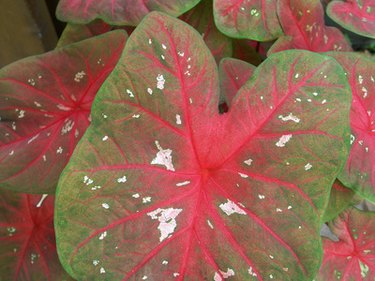
Elephant ear plants are large-leaved caladiums native to the tropical Americas and grown for their ornamental value. They are closely related to taro and several other large-leaved plants in the Aracea family, which are also called elephant ear plants. One close relative is Colocasia esculenta, or taro, which is grown across the tropics for its starchy corms (tubers). There are now hundreds of cultivars with colorful leaves up to 2 feet long. Elephant ears have an annual dormant phase during which their leaves die back to the tuber.
Step 1
Place your potted elephant ear on a bright windowsill that receives indirect sunshine and has a minimum temperature of 60 degrees Fahrenheit. Rotate the pot every week to keep growth even. Do not expose the plant to direct sunshine, as this will scorch the leaves.
Video of the Day
Step 2
Water your elephant ear when the surface of its potting medium starts to dry out. Water liberally but allow all the excess water to drain away, as water-logged soil will cause elephant ear roots and tubers to rot. Keep the pot on a dish or wet gravel to maintain humidity.
Step 3
Apply a liquid houseplant fertilizer at half the recommended strength once every two weeks during the growing season. Do not fertilize at all during the winter dormancy period.
Step 4
Keep your potted elephant ear plant in a cool, dry place during the winter when it has become dormant and its leaves have died back. A temperature of 55 to 60 degrees F is ideal. Keep the soil slightly moist by watering sparingly once a month.
Step 5
Move your plant back to a bright spot during the spring or as soon as the tubers begin to spout again. Most elephant ears have a dormancy period of around five months.
Step 6
Re-pot your tubers during the early spring before they have begun to grow new leaves. Use a peat-based compost and pots only one size larger than the original, to prevent excess soil from trapping water and water-logging the tubers. Plant the tubers 1-inch deep in the compost and water lightly to settle the soil. Do not fertilize until new leaves have emerged.
Tip
Reduce the amount of fertilizer if your elephant ear's natural colors appear dull. Remove any flowers that appear on your plant, as they sap energy away from leaf production. Propagate your plant by dividing the tuber into sections with a sterile knife. Make sure each section has at least two growth points or eyes.
Warning
Do not allow your elephant ear plant to dry out during the growing season, as it will enter dormancy. Do not store elephant ear corms at less than 50 degrees F., to prevent damage.
Video of the Day